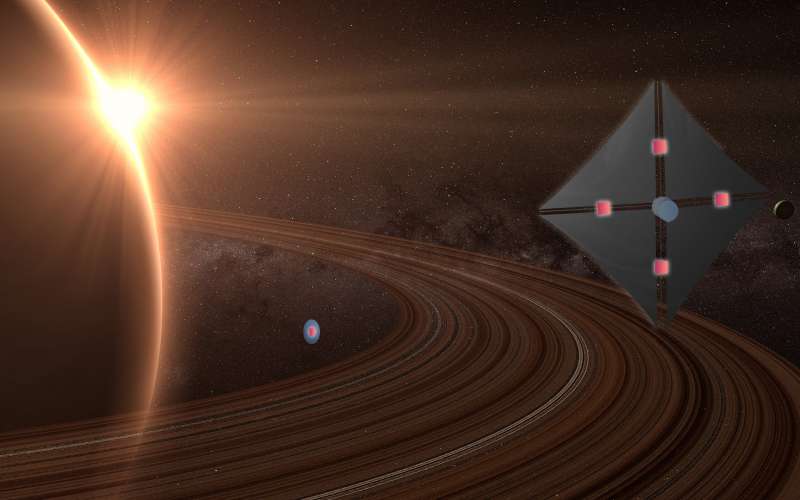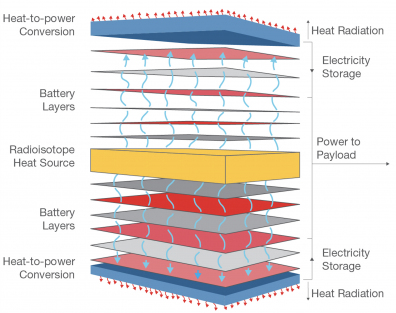Space exploration remains a herculean effort due to the immense challenges imposed by time and distance. While missions to near-Earth objects have been successfully accomplished using traditional means of propulsion, the outermost planets in our solar system are 2 to 3.7 billion miles from the Sun. Reaching them within any reasonable time frame requires propulsion systems that exceed the capabilities of conventional propulsion methods.
Solar sails harness the radiation pressure exerted by light on a reflective material to provide thrust to spacecraft. With few moving parts and the propellant offboard, solar sails provide cost-effective operations and long operating lifetimes. The technology is proven, and was successfully demonstrated by Japan’s IKAROS mission’s fly-by of Venus in 2010.
The Aerospace Corporation is researching new approaches to solar sail technology that could exponentially increase its already considerable potential, paving the way for a new era of breakthrough science missions.
Using the Sun for Propulsion
In collaboration with UCLA’s Mechanical and Aerospace Engineering Department and NASA’s Marshall Space Flight Center, Aerospace is now exploring the use of solar sails as a pathway to faster exploration of the outer solar system and interstellar space. The Extreme Solar Sailing concept offers to employ the Sun as a figurative launchpad, utilizing a “slingshot” maneuver to propel lightweight cubesat-class spacecraft to extremely high velocities.
This technology has the potential to enable missions to distant worlds in far less time, opening up new possibilities for space exploration. “With chemical propulsion, you can attain velocities between two to five astronomical units (AU) per year, with one AU being the distance between the Earth and the Sun,” said Dr. Henry Helvajian, Senior Scientist at Aerospace’s Physical Sciences Laboratories. “The beauty of extreme solar sailing is that you can gain velocities that surpass pretty much any kind of propulsion that we know of today, by factors of two to 10 to 30 depending on how close you want to get to the sun.”
Using this maneuver, solar sails can reach 0.1% of the speed of light (i.e., approx. 300 km/s), reaching the furthest planets of our solar system could take only months, interstellar space could be reached in a few years, and 1000 AU could be attained in less than 20 years.
These capabilities come with some concessions, however. The immense velocity of solar sail-driven spacecraft requires greatly reduced mass, necessitating new spacecraft architectures and materials that can withstand the initial close proximity to the Sun. In addition, solar sails must be resilient and able to provide consistent thrust while also withstanding impacts from dust and debris in their path.
Advancing Solar Sails for Deeper Space Exploration

The Extreme Solar Sailing proposal received NASA’s Innovative Advanced Concepts (NIAC) Phase 1 grant in 2020. While the Phase 1 study demonstrated the conceptual feasibility of extreme solar sailing and the materials it would require, the next phase will require the development of key elements and systems for mission success. The study has received a NIAC Phase 2 grant for the development, fabrication and testing of new, ultra-lightweight metamaterials for solar sails, as well as the design of spacecraft architecture that provides ultra-low mass with the greatest payload functionality, and the conduction of mission studies.
Proceeds from the Phase 2 grant will also explore the application of extreme solar sailing to two breakthrough mission concepts: the Fast Transit Interstellar Probe, which aims to send a probe to 500 AU in 10 years, and Corona-Net, a precursor mission, which aims to send a fleet of solar sails to examine the inner heliosphere at high inclination. Both mission concepts will also assess spacecraft communications and power requirements, and will explore the design of higher fidelity sail control systems to ensure precise navigation around the Sun and interstellar locations.
In addition to advancements in solar sail velocity, Aerospace is also working to expand other aspects of solar sail functionality such as the Atomic Planar Power for Lightweight Exploration (APPLE) concept, which also recently received a 2021 NIAC Phase 1 grant.
APPLE: Atomic Power and Energy Storage

While solar sails have the unique advantage of accessing the virtually infinite propulsive power of the Sun’s light, research is currently underway to explore the feasibility of adding energy generation and storage to solar sail technology in a bid for added resilience and functionality.
While nuclear power has typically been used in traditional spacecraft, limitations on mass have precluded its use in solar sails. Aerospace’s APPLE concept allows for a radioisotope energy source to be combined with energy storage in the form of a flat “power tile” battery that can be attached to the solar sails themselves.

“With APPLE, we’re integrating a few elements that are usually separated in spacecraft architecture. The radioisotope decay that powers spacecrafts in deep space creates heat, and that heat is converted into electricity in another material, which is then used by the spacecraft,” said Dr. Helvajian. “For APPLE, we’re integrating a type of lithium battery into the radioisotope itself. The reason we haven’t integrated batteries before is that when you place a traditional battery near a radioisotope decay source, the radioisotope emission destroys the battery. So, we’re exploring the development of a unique, isotopically-selected lithium to make a battery that’s radiation-resistant.“
If successful, this new generation of rechargeable battery could allow for storage of electricity generated by radioisotope decay for later use in higher-powered applications. In addition, waste heat generated by the radioisotope decay, which is normally dissipated, can be directed to keep spacecraft electronics warm in the frigid recesses of deep space. The APPLE’s concept may pave the way for more resilient battery architectures that can survive the punishing conditions of space, while further extending mission lifespans.
The Aerospace team of Drs. Joseph Nemanick, Kristine Ferrone and Helvajian are currently providing system and mission modeling to determine the power requirements for missions such as a Kuiper belt object fly-by and a mission to the solar gravity focal point, with radiation testing to be completed by the Oak Ridge National Laboratory (ORNL).
Expanding Capabilities, Expanding Access
Until other forms of propulsion become practical and attainable, solar sail technology may provide us a means of bypassing the limitations of conventional spacecraft propulsion, and may ultimately broaden access to space, making space exploration far more accessible to private enterprise and countries with nascent space programs. Aerospace continues to contribute its technical expertise toward the evolution of solar sail technology, and the new era of space exploration it may yield.

